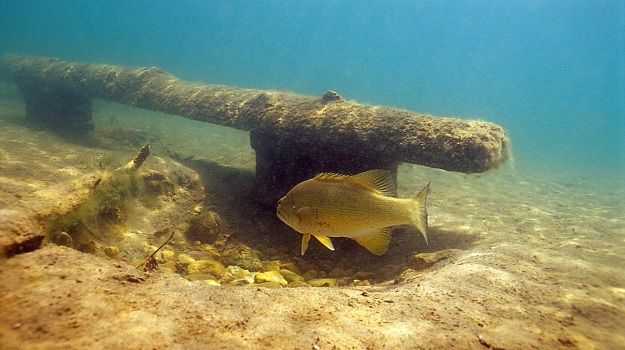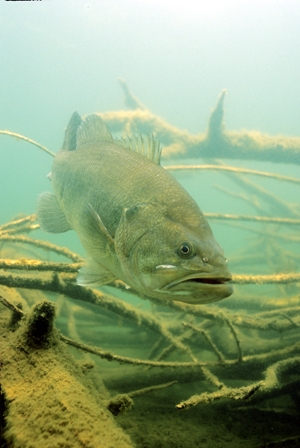
Reproductive Refuge
By Eric Engbretson
Fish managers often debate about what are some of the things we can do to help encourage spawning in bass species. Creating the right type of habitat is important and in northern states, fish managers sometimes use spawning benches to promote the reproduction of smallmouth bass. While largemouth bass, rock bass, and sometimes bluegill also use spawning benches, it is the spawning of smallmouth bass that inspired the design.
In a healthy lake smallmouth bass build spawning nests against rocks, sunken trees, or large pieces of wood at a depth of about four to ten feet of water. Next to these structures, the male excavates a shallow, circular crater in the bottom of the lake.
This system provides good natural protection to eggs and fry. But in lakes without coarse woody habitat, large rocks or similar objects, smallmouth bass may be forced to construct their nests out in the open. When spawning is over and the female has deposited eggs in the nest, the male diligently guards the eggs and later the fry from predatory fish and crayfish.
When the nests are out in the open without natural protection, the male must guard up to 360 degrees of the crater he has dug. This is exhausting and dangerous, since his back is always turned away from part of the nest. Far fewer eggs incubate, and far fewer fry survive their first few weeks when fish have to use nests that lack the natural shield of a habitat’s woody elements.
 Fish managers have studied the hard work put in by the bass and have noted the decreased recruitment of young fish. The managers came up with an idea for a simple structure they hoped would meet the needs of nesting fish and make it easier for eggs and fry to survive. The idea for spawning benches was born.
Fish managers have studied the hard work put in by the bass and have noted the decreased recruitment of young fish. The managers came up with an idea for a simple structure they hoped would meet the needs of nesting fish and make it easier for eggs and fry to survive. The idea for spawning benches was born.
A spawning bench consists of a four-to-six-foot piece of log sawed lengthwise in half and attached to a cinder block on each end. Spawning benches are therefore sometimes called “half logs.” Once placed on suitable substrate, the spawning bench provides overhead cover from birds of prey. The cinder blocks on each end protect the nest from raiders on two sides.
It was a sound design and one that smallmouth bass readily used, but not exactly as intended. It turned out that smallmouth bass weren’t concerned about overhead cover. The benches already sat in water deep enough to preclude threats from above by ospreys and other birds of prey. While nests are occasionally built between the two cinder blocks as the designers intended, smallmouth bass usually construct nests next to the block on one side or the other, thus allowing the male to guard the nest from only three sides. The key element seems to be the cinder block itself and not so much the half log. In fact, if the spawning bench falls on its side, it still provides excellent protection.
Spawning benches are poor substitutes for the naturally occurring woody cover that fish prefer. But in lakes devoid of suitable wood, rocks, or trees, spawning benches provide a superb means of helping smallmouth bass defend their nests and allowing more of their offspring to survive.
Eric Engbretson is a professional underwater photographer. Using a variety of snorkeling and diving gear, he specializes in underwater images of freshwater fish taken in their natural habitat. His photos are published widely in many fishing and outdoor magazines in North America, and he often speaks to various groups and organizations on the importance of fish habitat. www.underwaterfishphotos.com



























